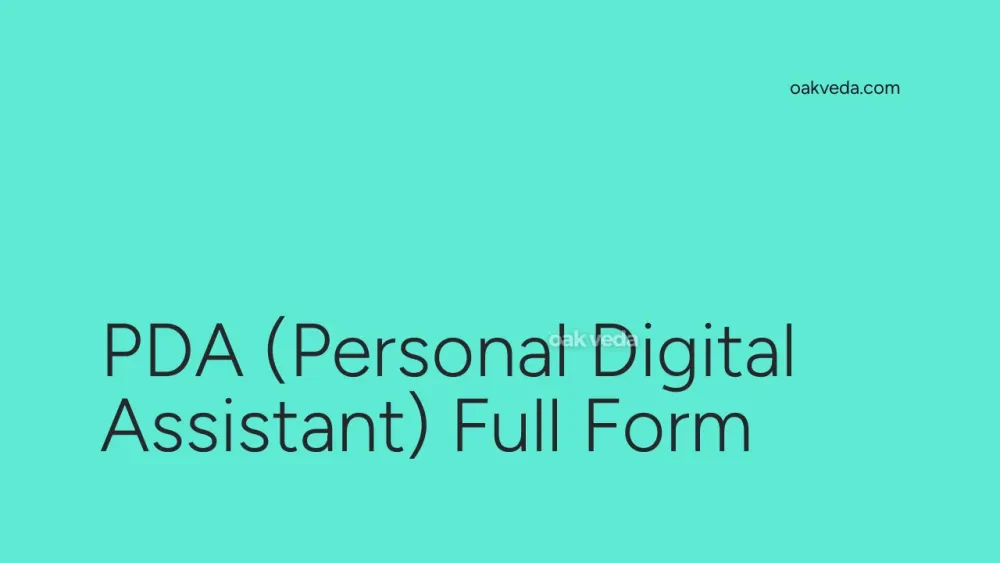
What is the Full Form of PDA?
The full form of PDA is Personal Digital Assistant. This compact, handheld device revolutionized personal computing in the 1990s and early 2000s, paving the way for modern smartphones and tablets.
What is a Personal Digital Assistant?
A Personal Digital Assistant, commonly known as PDA, is a small, portable computing device designed to help users manage personal information and perform various tasks on the go. These devices typically feature a touch-sensitive screen, allowing users to interact with the device using a stylus or their fingers.
Origin and Development of Personal Digital Assistants
The concept of PDAs emerged in the late 1980s, with the first commercially successful device, the Palm Pilot, launched in 1996. These early PDAs were primarily designed for personal information management, including calendars, address books, and to-do lists.
As technology advanced, PDAs evolved to include more features and capabilities, eventually merging with mobile phones to create the smartphones we use today.
How does a Personal Digital Assistant work?
Personal Digital Assistants operate on specialized operating systems designed for mobile use. They typically use:
- Touch-sensitive screens for input
- Stylus or finger-based interaction
- Handwriting recognition software
- Voice recognition technology (in later models)
- Synchronization with desktop computers for data backup and transfer
Types of Personal Digital Assistants
While PDAs have largely been replaced by smartphones, they once came in various forms:
- Pen-based PDAs: Relied primarily on stylus input
- Keyboard-based PDAs: Featured miniature QWERTY keyboards
- Hybrid PDAs: Combined touch screens with small keyboards
- PDA-phone hybrids: Early precursors to modern smartphones
Functions of Personal Digital Assistants
PDAs were designed to perform a wide range of tasks, including:
- Personal information management (calendars, contacts, notes)
- Email and basic web browsing
- Document viewing and editing
- Simple gaming
- GPS navigation (in later models)
- Voice recording
Applications of Personal Digital Assistants
PDAs found applications in various fields:
- Business: For scheduling, note-taking, and email management
- Healthcare: As mobile reference tools for medical professionals
- Education: For organizing assignments and taking notes
- Personal use: As digital organizers and entertainment devices
Features of Personal Digital Assistants
Key features of PDAs include:
- Compact, portable design
- Touch-sensitive screen
- Stylus or finger-based input
- Handwriting recognition
- Voice recognition (in some models)
- Wireless connectivity (Wi-Fi, Bluetooth)
- Expandable memory via memory card slots
- USB connectivity for data transfer and charging
- Built-in or add-on GPS capabilities
- Long battery life
Benefits of Personal Digital Assistants
PDAs offered several advantages:
- Portability: Easily carried in a pocket or small bag
- Versatility: Combined multiple functions in one device
- Improved productivity: Helped users manage time and information efficiently
- Customization: Allowed installation of third-party applications
- Extended battery life: Lasted longer than laptops of the time
Limitations or Challenges of Personal Digital Assistants
Despite their popularity, PDAs faced several challenges:
- Limited processing power compared to desktop computers
- Smaller screen size, making extended use challenging
- Difficulty in text input, especially for longer documents
- Limited internet capabilities compared to modern devices
- Fragmentation of operating systems and software ecosystems
Future Developments in Personal Digital Assistant Technology
While standalone PDAs have largely been phased out, their legacy lives on in modern smartphones and tablets. The concept of a personal digital assistant has evolved into AI-powered virtual assistants like Siri, Google Assistant, and Alexa, which offer voice-activated assistance across various devices.
Future developments in this field may include:
- More advanced AI integration
- Improved natural language processing
- Enhanced integration with smart home devices
- Augmented reality features
- Wearable technology advancements
FAQs on PDA Full Form
-
What does PDA mean in technology? In technology, PDA stands for Personal Digital Assistant, a handheld device for managing personal information and performing various tasks.
-
Are PDAs still used today? Traditional PDAs have largely been replaced by smartphones and tablets, which offer similar functionality with more advanced features.
-
What was the most popular PDA? The Palm Pilot series was one of the most popular and influential PDA lines in the late 1990s and early 2000s.
-
How did PDAs evolve into smartphones? PDAs gradually incorporated cellular connectivity and more advanced features, eventually merging with mobile phones to create the modern smartphone.
-
What operating systems did PDAs use? Common PDA operating systems included Palm OS, Windows CE (later Windows Mobile), and BlackBerry OS.
In conclusion, while Personal Digital Assistants may no longer exist as standalone devices, their influence on modern mobile technology is undeniable. The full form of PDA – Personal Digital Assistant – represents a crucial stepping stone in the evolution of portable computing devices, paving the way for the powerful smartphones and tablets we use today.
You may be interested in:

